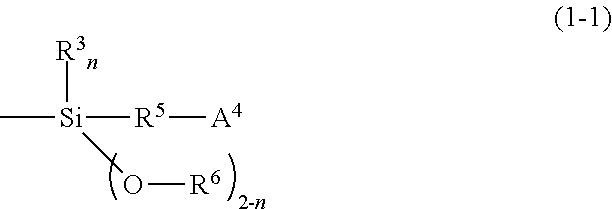Pneumatic tire and method for producing pneumatic tire
a pneumatic tire and pneumatic technology, applied in the field of pneumatic tires, can solve the problems of difficult to improve etc., and achieve the effect of improving fuel economy, rubber tensile strength, abrasion resistance, and maintaining adequate productivity
- Summary
- Abstract
- Description
- Claims
- Application Information
AI Technical Summary
Benefits of technology
Problems solved by technology
Method used
Image
Examples
synthesis example 1 (
Synthesis of Copolymer (1): SBR with a Degree of Hydrogenation of 0 mol %)
[0139]To a sufficiently nitrogen-purged heat-resistant reaction vessel were charged 2,000 mL of n-hexane, 60 g of styrene, 140 g of butadiene, 2.5 g of THF, and 0.45 mmol of n-butyllithium, followed by stirring at 50° C. for five hours to cause a polymerization reaction. After the reaction was terminated by addition of ethanol, 1 g of 2, 6-di-tert-butyl-p-cresol was added to the reaction solution. The resulting solution was purified by reprecipitation to obtain copolymer (1). The copolymer (1) had a weight average molecular weight (Mw) of 490,000 and a styrene content of 30% by mass.
synthesis example 2 (
Synthesis of Copolymer (2): Hydrogenated SBR with a Degree of Hydrogenation of 60 mol %)
[0140]Copolymer (2) was produced as in the synthesis of copolymer (1), except that the obtained polymer was hydrogenated. Specifically, after the polymerization conversion reaction in the synthesis of copolymer (1), the polymerization reaction was not terminated by addition of ethanol. Instead, the reaction solution was then stirred for 20 minutes while supplying hydrogen gas at a pressure of 0.4 MPa gauge to react the unreacted polymer terminal lithium with hydrogen into lithium hydride. Hydrogenation was carried out using a titanocene dichloride-based catalyst at a hydrogen gas supply pressure of 0.7 MPa gauge and a reaction temperature of 90° C. Once the cumulative amount of absorbed hydrogen reached the amount corresponding to the target degree of hydrogenation, the reaction temperature was brought to room temperature and the hydrogen pressure was returned to an ordinary pressure. Thereafter,...
synthesis example 3 (
Synthesis of Copolymer (3): Hydrogenated SBR with a Degree of Hydrogenation of 80 mol %)
[0141]Copolymer (3) was produced as in the synthesis of copolymer (2), except that the cumulative amount of absorbed hydrogen was adjusted so as to correspond to the target degree of hydrogenation. The copolymer (3) had a degree of hydrogenation of 80 mol % and a weight average molecular weight (Mw) of 520,000.
PUM
| Property | Measurement | Unit |
|---|---|---|
| Tg | aaaaa | aaaaa |
| Tg | aaaaa | aaaaa |
| Tg | aaaaa | aaaaa |
Abstract
Description
Claims
Application Information
 Login to View More
Login to View More - R&D
- Intellectual Property
- Life Sciences
- Materials
- Tech Scout
- Unparalleled Data Quality
- Higher Quality Content
- 60% Fewer Hallucinations
Browse by: Latest US Patents, China's latest patents, Technical Efficacy Thesaurus, Application Domain, Technology Topic, Popular Technical Reports.
© 2025 PatSnap. All rights reserved.Legal|Privacy policy|Modern Slavery Act Transparency Statement|Sitemap|About US| Contact US: help@patsnap.com



